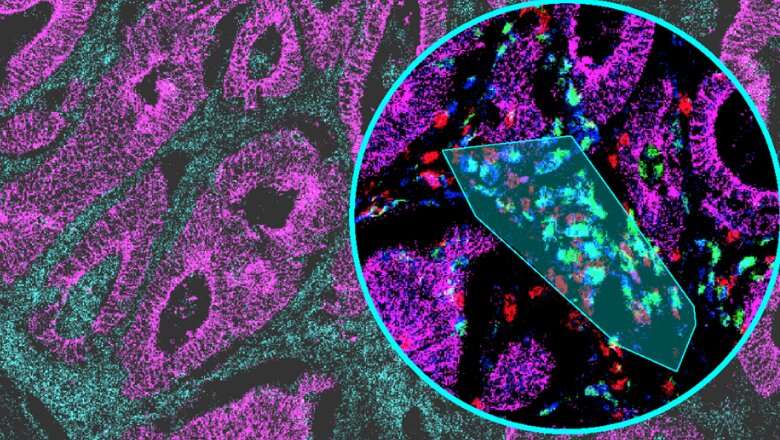IMC image of a human colorectal cancer obtained with SIMPLI. Circled is a region with high-density of cytotoxic CD8 T cells and antigen-resenting macrophages. Magenta = tumor; red = CD8; cyan = B2M; green = CD68; blue = CD74. Credit: Lucia Montorsi
A team of researchers from the King's College London Schools of Cancer & Pharmaceutical Sciences and Immunology and Microbial Sciences and the Cancer Systems Biology laboratory at the Francis Crick Institute, led by Professor Francesca Ciccarelli, have published new paper showcasing novel software for the analysis of complex tissue imaging data.
Recently developed multiplexed imaging technologies, such imaging mass cytometry (IMC), enable detailed investigation of tissue cell composition that are of particular value for mapping the tissue-level characteristics of disease and predicting the outcome of therapies that depend on the tissue environment, such as cancer immunotherapy. These techniques usually produce large amounts of high dimensional data that are difficult to analyze and often require multiple tools and users with computational expertise.
SIMPLI (Single-cell Identification from MultiPlexed Images) is a flexible software that unifies all steps of multiplexed imaging data analysis, providing an improved alternative to high-dimension imaging data analysis also for non-specialists. SIMPLI performs a spatially resolved, single-cell analysis of each tissue slide as well as cell-independent quantifications of marker expression to investigate features undetectable at the cell level. It also produces tabular and graphical outputs that faciliate the visual inspection of results at each step of the analysis.
"When we started to work with high dimensional IMC data a couple of years ago, there were not many tools for their analysis. It has been a lot of fun do develop our own tool thanks to the talent of Michele Bortolomeazzi, a Ph.D. student funded by the CRUK KHP Centre, and taking advantage of the vast expertise in tissue histology of Professor Jo Spencer," said Prof. Francesca Ciccarelli.
To test the performance and versatility of SIMPLI, the researchers analyzed images that had been obtained with different imaging technologies, including but not limited to IMC, and were diverse in origin, size and resolution.
King's College London has been one of the first Institutions in Europe to host a Helios imaging mass cytometer, which is available in the BRC Flow Cytometry Platform.
More information: Michele Bortolomeazzi et al, A SIMPLI (Single-cell Identification from MultiPLexed Images) approach for spatially-resolved tissue phenotyping at single-cell resolution, Nature Communications (2022). DOI: 10.1038/s41467-022-28470-x
Journal information: Nature Communications
Provided by King's College London
























